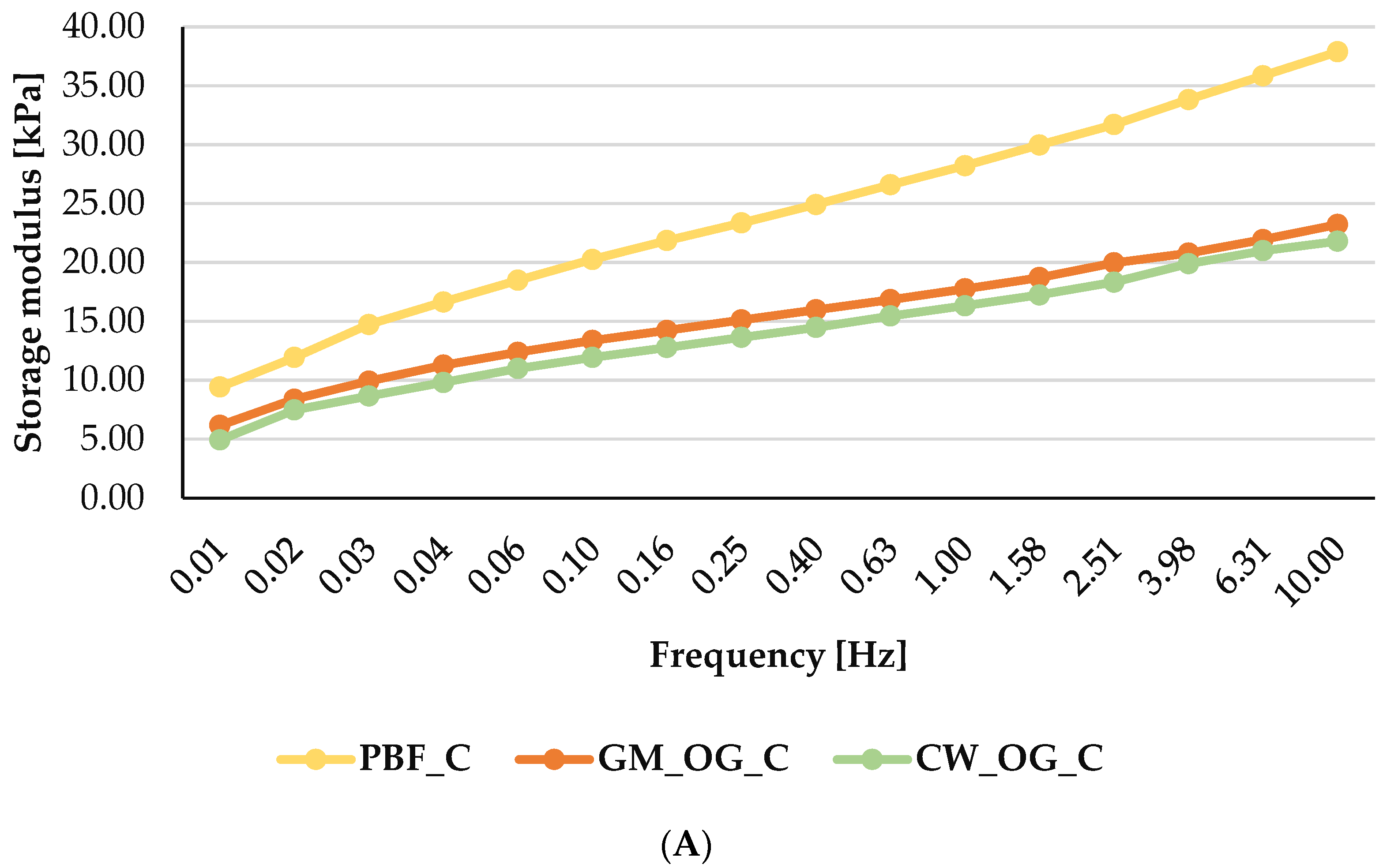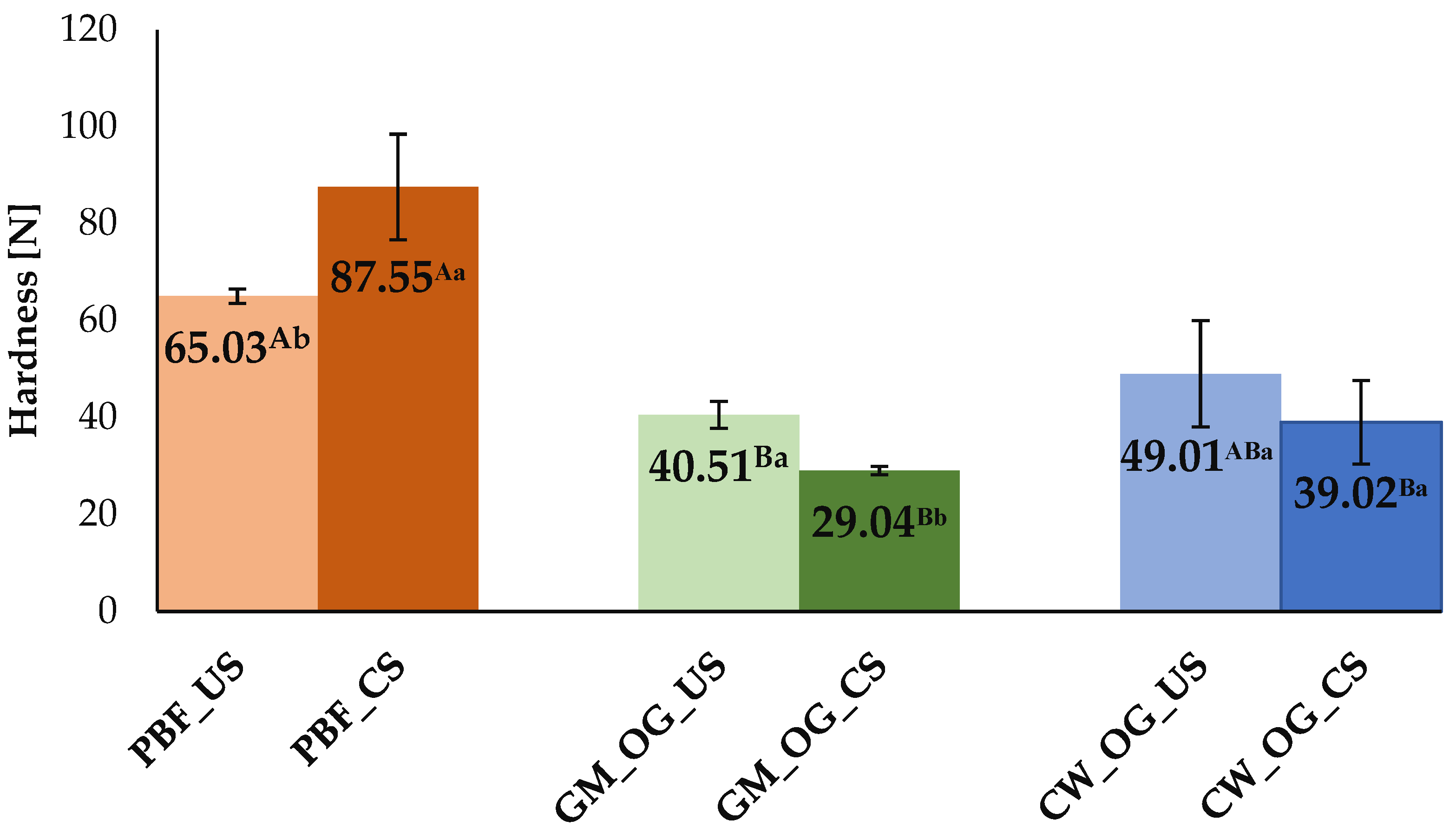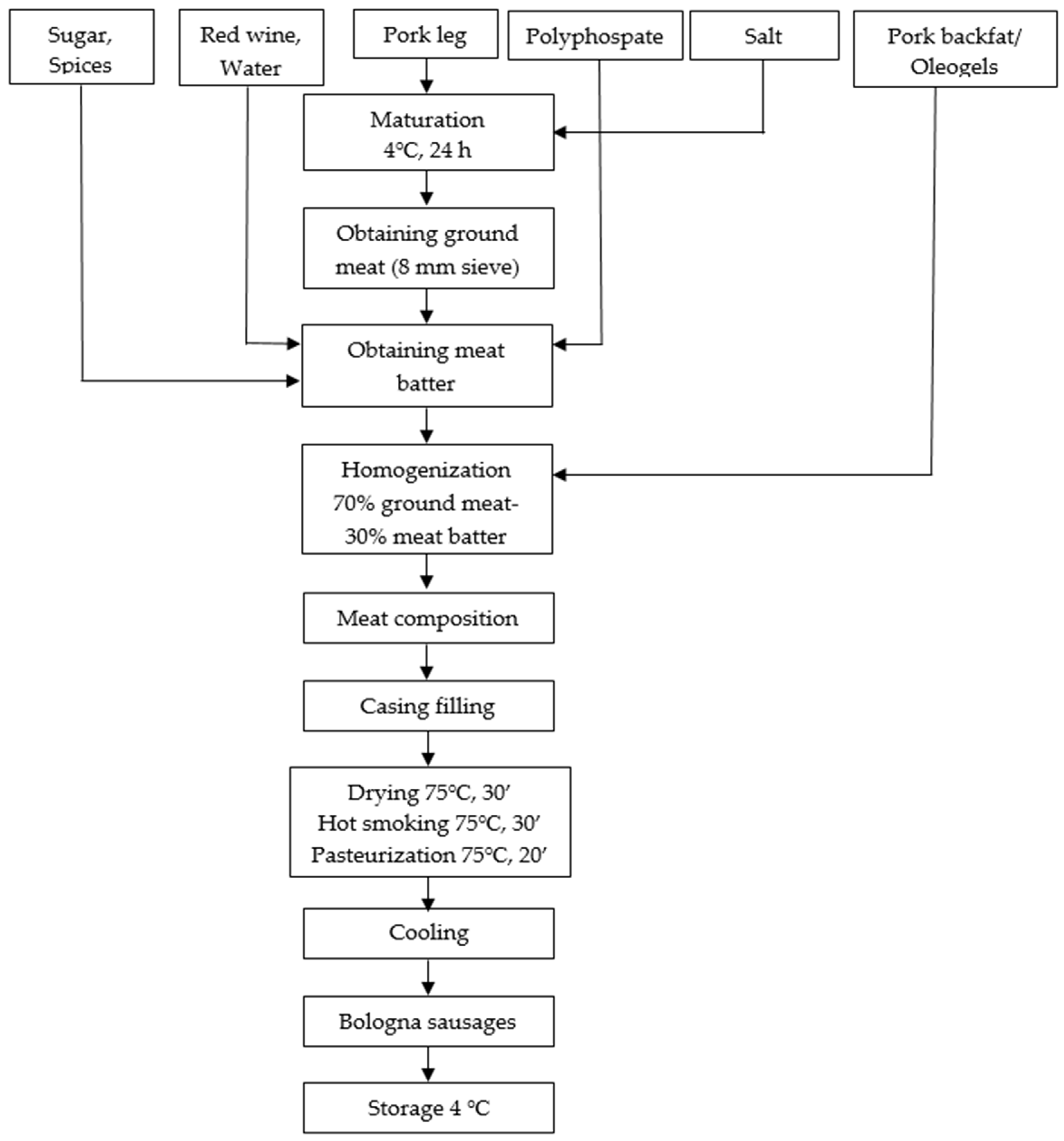Candelilla Wax and Glycerol Monostearate-Based Oleogels as Animal Fat Substitutes in Bologna Sausages
Abstract
1. Introduction
2. Results and Discussion
2.1. Oleogel Characterization
2.1.1. Texture Profile Analysis
2.1.2. Oil Binding Capacity
2.2. Meat Composition Characterization
2.2.1. Texture Profile Analysis
2.2.2. Fat Loss
2.2.3. Rheology
2.2.4. Color
2.3. Finished Product Characterization
2.3.1. Texture Analysis
2.3.2. Color
3. Conclusions
4. Materials and Methods
4.1. Materials
4.2. Preparation of Oleogels
4.3. The Manufacturing Process of Bologna Sausages
4.4. Oleogel Characterization
4.4.1. Texture Profile Analysis
4.4.2. Oil Binding Capacity
4.5. Meat Composition Characterization
4.5.1. Texture Profile Analysis
4.5.2. Fat Loss
4.5.3. Rheology
4.6. Finished Products Characterization
Texture
4.7. Color
4.8. Statistical Analysis
Author Contributions
Funding
Institutional Review Board Statement
Informed Consent Statement
Data Availability Statement
Acknowledgments
Conflicts of Interest
References
- de Souza Paglarini, C.; Vidal, V.A.; Ribeiro, W.; Badan Ribeiro, A.P.; Bernardinelli, O.D.; Herrero, A.M.; Ruiz-Capillas, C.; Sabadini, E.; Rodrigues Pollonio, M.A. Using inulin-based emulsion gels as fat substitute in salt reduced Bologna sausage. J. Sci. Food Agric. 2021, 101, 505–517. [Google Scholar] [CrossRef]
- Paglarini, C.S.; Vidal, V.A.S.; Dos Santos, M.; Coimbra, L.O.; Esmerino, E.A.; Cruz, A.G.; Pollonio, M.A.R. Using dynamic sensory techniques to determine drivers of liking in sodium and fat-reduced Bologna sausage containing functional emulsion gels. Food Res. Int. 2020, 132, 109066. [Google Scholar] [CrossRef] [PubMed]
- Magalhães, I.M.C.; Paglarini, C.d.S.; Vidal, V.A.S.; Pollonio, M.A.R. Bamboo fiber improves the functional properties of reduced salt and phosphate-free Bologna sausage. J. Food Process. Preserv. 2020, 44, e14929. [Google Scholar] [CrossRef]
- Cirstea Lazar, N.; Nour, V.; Corbu, A.R.; Muntean, C.; Codina, G.G. Reformulation of Bologna Sausage by Total Pork Backfat Replacement with an Emulsion Gel Based on Olive, Walnut, and Chia Oils, and Stabilized with Chitosan. Foods 2023, 12, 3455. [Google Scholar] [CrossRef] [PubMed]
- Ferro, A.C.; de Souza Paglarini, C.; Rodrigues Pollonio, M.A.; Lopes Cunha, R. Glyceryl monostearate-based oleogels as a new fat substitute in meat emulsion. Meat Sci. 2021, 174, 108424. [Google Scholar] [CrossRef] [PubMed]
- Libera, J.; Iłowiecka, K.; Stasiak, D. Consumption of processed red meat and its impact on human health: A review. Int. J. Food Sci. Technol. 2021, 56, 6115–6123. [Google Scholar] [CrossRef]
- WHO. Interim Summary of Conclusions and Dietary Recommendations on Total Fat & Fatty Acids. Available online: https://www.foodpolitics.com/wp-content/uploads/FFA_summary_rec_conclusion.pdf (accessed on 19 April 2024).
- U.S. Department of Health and Human Services. Dietary Guidelines for Americans. Available online: https://health.gov/sites/default/files/2019-09/2015-2020_Dietary_Guidelines.pdf (accessed on 19 April 2024).
- Paglarini, C.S.; Vidal, V.A.S.; Martini, S.; Cunha, R.L.; Pollonio, M.A.R. Protein-based hydrogelled emulsions and their application as fat replacers in meat products: A review. Crit. Rev. Food Sci. Nutr. 2022, 62, 640–655. [Google Scholar] [CrossRef] [PubMed]
- Puscas, A.; Muresan, V.; Socaciu, C.; Muste, S. Oleogels in Food: A Review of Current and Potential Applications. Foods 2020, 9, 70. [Google Scholar] [CrossRef]
- López-Pedrouso, M.; Lorenzo, J.M.; Gullón, B.; Campagnol, P.C.B.; Franco, D. Novel strategy for developing healthy meat products replacing saturated fat with oleogels. Curr. Opin. Food Sci. 2021, 40, 40–45. [Google Scholar] [CrossRef]
- Perta-Crisan, S.; Ursachi, C.S.; Chereji, B.D.; Munteanu, F.D. Oleogels-Innovative Technological Solution for the Nutritional Improvement of Meat Products. Foods 2022, 12, 131. [Google Scholar] [CrossRef]
- Hwang, H.-S. A critical review on structures, health effects, oxidative stability, and sensory properties of oleogels. Biocatal. Agric. Biotechnol. 2020, 26, 101657. [Google Scholar] [CrossRef]
- Martin-Illana, A.; Notario-Perez, F.; Cazorla-Luna, R.; Ruiz-Caro, R.; Bonferoni, M.C.; Tamayo, A.; Veiga, M.D. Bigels as drug delivery systems: From their components to their applications. Drug Discov. Today 2021, 27, 1008–1026. [Google Scholar] [CrossRef] [PubMed]
- Malvano, F.; Laudisio, M.; Albanese, D.; d’Amore, M.; Marra, F. Olive Oil-Based Oleogel as Fat Replacer in a Sponge Cake: A Comparative Study and Optimization. Foods 2022, 11, 2643. [Google Scholar] [CrossRef] [PubMed]
- Rehab Gab-Allah, H. Manufacture of pickled and un-pickled high fat soft cheese using olive and sunflower oleogels. Middle East J. Appl. Sci. 2018, 08, 223–230. [Google Scholar]
- Jing, X.; Chen, Z.; Tang, Z.; Tao, Y.; Huang, Q.; Wu, Y.; Zhang, H.; Li, X.; Liang, J.; Liu, Z.; et al. Preparation of camellia oil oleogel and its application in an ice cream system. LWT 2022, 169, 113985. [Google Scholar] [CrossRef]
- Abdolmaleki, K.; Alizadeh, L.; Nayebzadeh, K.; Baranowska, H.M.; Kowalczewski, P.Ł.; Mousavi Khaneghah, A. Potential Application of Hydrocolloid-Based Oleogel and Beeswax Oleogel as Partial Substitutes of Solid Fat in Margarine. Appl. Sci. 2022, 12, 2136. [Google Scholar] [CrossRef]
- Puscas, A.; Muresan, V. The Feasibility of Shellac Wax Emulsion Oleogels as Low-Fat Spreads Analyzed by Means of Multidimensional Statistical Analysis. Gels 2022, 8, 749. [Google Scholar] [CrossRef] [PubMed]
- Bascuas, S.; Espert, M.; Llorca, E.; Quiles, A.; Salvador, A.; Hernando, I. Structural and sensory studies on chocolate spreads with hydrocolloid-based oleogels as a fat alternative. LWT 2021, 135, 110228. [Google Scholar] [CrossRef]
- Palla, C.A.; Wasinger, M.F.; Carrin, M.E. Monoglyceride oleogels as fat replacers in filling creams for sandwich cookies. J. Sci. Food Agric. 2021, 101, 2398–2405. [Google Scholar] [CrossRef] [PubMed]
- da Silva, S.L.; Amaral, J.T.; Ribeiro, M.; Sebastiao, E.E.; Vargas, C.; de Lima Franzen, F.; Schneider, G.; Lorenzo, J.M.; Fries, L.L.M.; Cichoski, A.J.; et al. Fat replacement by oleogel rich in oleic acid and its impact on the technological, nutritional, oxidative, and sensory properties of Bologna-type sausages. Meat Sci. 2019, 149, 141–148. [Google Scholar] [CrossRef]
- Tarté, R.; Paulus, J.S.; Acevedo, N.C.; Prusa, K.J.; Lee, S.-L. High-oleic and conventional soybean oil oleogels structured with rice bran wax as alternatives to pork fat in mechanically separated chicken-based bologna sausage. LWT 2020, 131, 109659. [Google Scholar] [CrossRef]
- Aranda-Ledesma, N.E.; Bautista-Hernández, I.; Rojas, R.; Aguilar-Zárate, P.; Medina-Herrera, N.d.P.; Castro-López, C.; Guadalupe Martínez-Ávila, G.C. Candelilla wax: Prospective suitable applications within the food field. LWT 2022, 159, 113170. [Google Scholar] [CrossRef]
- EFSA. Scientific Opinion on the Re-Evaluation of Candelilla Wax (E 902) as a Food Additive. Available online: https://www.efsa.europa.eu/en/efsajournal/pub/2946 (accessed on 19 April 2024).
- FDA. CFR—Code of Federal Regulations Title 21, Sec. 184.1976 Candelilla Wax. Available online: https://www.accessdata.fda.gov/scripts/cdrh/cfdocs/cfcfr/CFRSearch.cfm?fr=184.1976&SearchTerm=candelilla%20wax (accessed on 19 April 2024).
- Keskin Uslu, E.; Yılmaz, E. Preparation and characterization of glycerol monostearate and polyglycerol stearate oleogels with selected amphiphiles. Food Struct. 2021, 28, 100192. [Google Scholar] [CrossRef]
- Zhang, R.; Zhang, Y.; Yu, J.; Gao, Y.; Mao, L. Rheology and Tribology of Ethylcellulose-Based Oleogels and W/O Emulsions as Fat Substitutes: Role of Glycerol Monostearate. Foods 2022, 11, 2364. [Google Scholar] [CrossRef] [PubMed]
- EFSA. Re-Evaluation of Mono- and Di-Glycerides of Fatty Acids (E 471) as Food Additives. Available online: https://www.efsa.europa.eu/en/efsajournal/pub/5045 (accessed on 19 April 2024).
- FDA. CFR—Code of Federal Regulations Title 21, Sec. 184.1324 Glyceryl Monostearate. Available online: https://www.accessdata.fda.gov/scripts/cdrh/cfdocs/cfcfr/cfrsearch.cfm?fr=184.1324 (accessed on 19 April 2024).
- Paulus, J.S.; Prusa, K.J.; Acevedo, N.C.; Tarté, R.; Lee, S.-L. Replacement of Pork Fat in Chicken-based Bologna Sausage with Oleogels of High-Oleic or Conventional Soybean Oil and Rice Bran Wax. Iowa State Univ. Anim. Ind. Rep. 2021, 17, 14442. [Google Scholar] [CrossRef]
- Paulus, J.S.; Acevedo, N.C.; Sebranek, J.G.; Prusa, K.J.; Dickson, J.S.; Tarte, R. Utilization of Conventional and High Oleic Soybean Oil Oleogels Structured with Rice Bran Wax to Replace Pork Fat in Mechanically Separated Chicken-Based Bologna sausages. Meat Muscle Biol. 2019, 3, 53. [Google Scholar] [CrossRef]
- de Oliveira Faria, M.; Cipriano, T.M.; da Cruz, A.G.; Santos, B.A.; Pollonio, M.A.; Campagnol, P.C. Properties of bologna-type sausages with pork back-fat replaced with pork skin and amorphous cellulose. Meat Sci. 2015, 104, 44–51. [Google Scholar] [CrossRef] [PubMed]
- Brookfield Engineering Labs., I. Brookfield Engineering Labs., I. TextureProCT Manual No.M08-373.
- Lim, J.; Hwang, H.-S.; Lee, S. Oil-structuring characterization of natural waxes in canola oil oleogels: Rheological, thermal, and oxidative properties. Appl. Biol. Chem. 2016, 60, 17–22. [Google Scholar] [CrossRef]
- Trujillo-Ramirez, D.; Lobato-Calleros, C.; Jaime Vernon-Carter, E.; Alvarez-Ramirez, J. Cooling rate, sorbitan and glyceryl monostearate gelators elicit different microstructural, viscoelastic and textural properties in chia seed oleogels. Food Res. Int. 2019, 119, 829–838. [Google Scholar] [CrossRef]
- Pandolsook, S.; Kupongsak, S. Influence of bleached rice bran wax on the physicochemical properties of organogels and water-in-oil emulsions. J. Food Eng. 2017, 214, 182–192. [Google Scholar] [CrossRef]
- Morales, E.; Iturra, N.; Contardo, I.; Quilaqueo, M.; Franco, D.; Rubilar, M. Fat replacers based on oleogelation of beeswax/shellac wax and healthy vegetable oils. LWT 2023, 185, 115144. [Google Scholar] [CrossRef]
- Su, C.; Li, Y.; Zhu, J.; Gao, Y.; Li, Q.; Du, S.; Yu, X. Effect of flaxseed gum on the brittleness of oleogels based on candelilla wax. RSC Adv. 2022, 12, 30734–30741. [Google Scholar] [CrossRef] [PubMed]
- Tanislav, A.E.; Puscas, A.; Paucean, A.; Muresan, A.E.; Semeniuc, C.A.; Muresan, V.; Mudura, E. Evaluation of Structural Behavior in the Process Dynamics of Oleogel-Based Tender Dough Products. Gels 2022, 8, 317. [Google Scholar] [CrossRef] [PubMed]
- Barbut, S.; Marangoni, A. Organogels use in meat processing—Effects of fat/oil type and heating rate. Meat Sci. 2019, 149, 9–13. [Google Scholar] [CrossRef] [PubMed]
- Alejandre, M.; Astiasaran, I.; Ansorena, D.; Barbut, S. Using canola oil hydrogels and organogels to reduce saturated animal fat in meat batters. Food Res. Int. 2019, 122, 129–136. [Google Scholar] [CrossRef] [PubMed]
- de Souza Paglarini, C.; de Figueiredo Furtado, G.; Honório, A.R.; Mokarzel, L.; da Silva Vidal, V.A.; Ribeiro, A.P.B.; Cunha, R.L.; Pollonio, M.A.R. Functional emulsion gels as pork back fat replacers in Bologna sausage. Food Struct. 2019, 20, 100105. [Google Scholar] [CrossRef]
- Ferreira Ignácio Câmara, A.K.; Midori Ozaki, M.; Santos, M.; Silva Vidal, V.A.; Oliveira Ribeiro, W.; de Souza Paglarini, C.; Bernardinelli, O.D.; Sabadini, E.; Rodrigues Pollonio, M.A. Olive oil-based emulsion gels containing chia (Salvia hispanica L.) mucilage delivering healthy claims to low-saturated fat Bologna sausages. Food Struct. 2021, 28, 100187. [Google Scholar] [CrossRef]
- Panagiotopoulou, E.; Moschakis, T.; Katsanidis, E. Sunflower oil organogels and organogel-in-water emulsions (part II): Implementation in frankfurter sausages. LWT 2016, 73, 351–356. [Google Scholar] [CrossRef]
- Wolfer, T.L.; Acevedo, N.C.; Prusa, K.J.; Sebranek, J.G.; Tarte, R. Replacement of pork fat in frankfurter-type sausages by soybean oil oleogels structured with rice bran wax. Meat Sci. 2018, 145, 352–362. [Google Scholar] [CrossRef]
- Barbut, S.; Wood, J.; Marangoni, A. Potential use of organogels to replace animal fat in comminuted meat products. Meat Sci. 2016, 122, 155–162. [Google Scholar] [CrossRef]
- Barbut, S.; Wood, J.; Marangoni, A.G. Effects of Organogel Hardness and Formulation on Acceptance of Frankfurters. J. Food Sci. 2016, 81, C2183–C2188. [Google Scholar] [CrossRef] [PubMed]
- Berasategi, I.; Garcia-Iniguez de Ciriano, M.; Navarro-Blasco, I.; Calvo, M.I.; Cavero, R.Y.; Astiasaran, I.; Ansorena, D. Reduced-fat bologna sausages with improved lipid fraction. J. Sci. Food Agric. 2014, 94, 744–751. [Google Scholar] [CrossRef] [PubMed]
- Martins, A.J.; Lorenzo, J.M.; Franco, D.; Vicente, A.A.; Cunha, R.L.; Pastrana, L.M.; Quiñones, J.; Cerqueira, M.A. Omega-3 and Polyunsaturated Fatty Acids-Enriched Hamburgers Using Sterol-Based Oleogels. Eur. J. Lipid Sci. Technol. 2019, 121, 1900111. [Google Scholar] [CrossRef]
- Monto, A.R.; Yuan, L.; Xiong, Z.; Shi, T.; Li, M.; Wang, X.; Jin, W.; Li, J.; Gao, R. α-tocopherol stabilization by soybean oil and glyceryl monostearate made oleogel: Dynamic changes and characterization for food application. LWT 2023, 187, 115325. [Google Scholar] [CrossRef]
- Li, S.; Chen, J.; Liu, Y.; Qiu, H.; Gao, W.; Che, K.; Zhou, B.; Liu, R.; Hu, W. Preparation of Citral Oleogel and Antimicrobial Properties. Gels 2023, 9, 930. [Google Scholar] [CrossRef] [PubMed]
- Zheng, H.; Xiong, G.; Han, M.; Deng, S.; Xu, X.; Zhou, G. High pressure/thermal combinations on texture and water holding capacity of chicken batters. Innov. Food Sci. Emerg. Technol. 2015, 30, 8–14. [Google Scholar] [CrossRef]
- Jiménez-Colmenero, F.; Herrero, A.; Pintado, T.; Solas, M.T.; Ruiz-Capillas, C. Influence of emulsified olive oil stabilizing system used for pork backfat replacement in frankfurters. Food Res. Int. 2010, 43, 2068–2076. [Google Scholar] [CrossRef]
- Güemes-Vera, N.; Zamora-Natera, J.F.; Soto, S.S. Frankfurter sausage texture is affected by using isolate, concentrate and flour of Lupinus albus and pork skin proteins. Food Res. 2018, 2, 234–239. [Google Scholar] [CrossRef]
- Paciulli, M.; Littardi, P.; Carini, E.; Paradiso, V.M.; Castellino, M.; Chiavaro, E. Inulin-based emulsion filled gel as fat replacer in shortbread cookies: Effects during storage. LWT 2020, 133, 109888. [Google Scholar] [CrossRef]




| Parameters | GM_OG | CW_OG |
|---|---|---|
| Texture profile analysis | ||
| Hardness [N] | 12.27 A ± 0.42 | 28.96 A ± 0.33 |
| Adhesiveness [mJ] | 34.80 A ± 13.58 | 40.87 A ± 11.61 |
| Cohesiveness [n.a] | 0.17 A ± 0.04 | 0.12 A ± 0.04 |
| Oil binding capacity [%] | 99.28 A ± 0.44 | 100.00 A ± 0.00 |
| Parameters | PBF_C | GM_OG_C | CW_OG_C |
|---|---|---|---|
| Texture profile analysis | |||
| Hardness [N] | 25.23 A ± 6.82 | 12.27 B ± 2.35 | 13.08 B ± 1.94 |
| Adhesiveness [mJ] | 53.33 A ± 24.43 | 43.90 A ± 14.64 | 72.27 A ± 10.78 |
| Cohesiveness [n.a] | 0.51 A ± 0.06 | 0.62 A ± 0.07 | 0.62 A ± 0.09 |
| Springiness index | 1.00 A ± 0.01 | 0.91 A ± 0.06 | 0.99 A ± 0.04 |
| Gumminess [N] | 12.75 A ± 3.00 | 7.62 B ± 1.29 | 8.00 AB ± 0.68 |
| Fat loss [%] | 1.05 C ± 0.05 | 7.75 A ± 0.74 | 5.81 B ± 0.32 |
| Color | |||
| L* | 64.33 A ± 1.46 | 52.42 B ± 0.80 | 52.11 B ± 1.09 |
| a* | 5.98 A ± 0.38 | 6.32 A ± 0.37 | 5.33 B ± 0.41 |
| b* | 10.25 A ± 0.43 | 8.94 B ± 0.46 | 8.66 B ± 0.97 |
| ΔE | - | 11.99 | 12.34 |
| Whiteness | 62.40 | 51.17 | 51.04 |
| C* | 7.56 | 7.78 | 13.61 |
| Parameters | PBF_US | GM_OG_US | CW_OG_US | PBF_CS | GM_OG_CS | CW_OG_CS |
|---|---|---|---|---|---|---|
| External surface color | ||||||
| L* | 52.62 Aa ± 4.88 | 57.74 Aa ± 4.08 | 57.57 Aa ± 1.03 | 49.53 Ba ± 1.83 | 55.55 Aa ± 2.24 | 53.16 Ab ± 1.87 |
| a* | 13.59 Ab ± 2.01 | 9.72 Bb ± 0.97 | 10.05 Bb ± 1.22 | 17.64 Aa ± 1.09 | 12.87 Ba ± 1.12 | 13.60 Ba ± 1.88 |
| b* | 14.79 Ab ± 1.39 | 12.51 Bb ± 0.89 | 15.12 Ab ± 0.99 | 18.16 Aa ± 0.61 | 17.08 Aa ± 0.91 | 17.50 Aa ± 1.18 |
| ΔE | - | 6.81 | 6.09 | - | 7.76 | 5.47 |
| Whiteness | 48.54 | 54.87 | 53.85 | 43.53 | 50.67 | 48.18 |
| C* | 17.56 | 12.23 | 13.82 | 7.01 | 10.22 | 15.37 |
| Cross-section color | ||||||
| L* | 55.10 Aa ± 3.56 | 56.26 Aa ± 6.58 | 59.39 Aa ± 2.65 | 58.70 Aa ± 3.60 | 59.09 Aa ± 1.40 | 60.82 Aa ± 2.51 |
| a* | 12.29 Ab ± 0.89 | 12.80 Aa ± 2.13 | 11.51 Ab ± 0.89 | 15.18 Aa ± 1.29 | 14.28 Aa ± 1.12 | 14.12 Aa ± 1.15 |
| b* | 6.16 Bb ± 1.13 | 7.77 Ab ± 0.87 | 8.20 Aa ± 1.07 | 8.53 Ba ± 0.62 | 11.65 Aa ± 2.64 | 9.76 ABa ± 1.56 |
| ΔE | - | 2.05 | 4.81 | - | 3.27 | 2.67 |
| Whiteness | 53.04 | 53.76 | 57.00 | 55.18 | 55.13 | 57.23 |
| C* | 19.75 | 20.07 | 15.17 | 11.19 | 24.03 | 17.97 |
| Ingredients | PBF | GM_OG | CW_OG |
|---|---|---|---|
| Boneless and fatless pork leg | 70 | 70 | 70 |
| Pork backfat | 30 | - | - |
| Glycerol monostearate oleogel | - | 30 | - |
| Candelilla wax oleogel | - | - | 30 |
| Sugar | 1.430 | 1.430 | 1.430 |
| Nutmeg | 0.118 | 0.118 | 0.118 |
| Allspice | 0.034 | 0.034 | 0.034 |
| Red sweet pepper powder | 0.049 | 0.049 | 0.049 |
| Garlic powder | 0.025 | 0.025 | 0.025 |
| Polyphosphate | 0.350 | 0.350 | 0.350 |
| Red wine | 2.006 | 2.006 | 2.006 |
| Water | 3.478 | 3.478 | 3.478 |
Disclaimer/Publisher’s Note: The statements, opinions and data contained in all publications are solely those of the individual author(s) and contributor(s) and not of MDPI and/or the editor(s). MDPI and/or the editor(s) disclaim responsibility for any injury to people or property resulting from any ideas, methods, instructions or products referred to in the content. |
© 2024 by the authors. Licensee MDPI, Basel, Switzerland. This article is an open access article distributed under the terms and conditions of the Creative Commons Attribution (CC BY) license (https://creativecommons.org/licenses/by/4.0/).
Share and Cite
Tanislav, A.E.; Cornea, A.A.; Radu, E.D.; Țibulcă, D.; Mureșan, V.; Mudura, E. Candelilla Wax and Glycerol Monostearate-Based Oleogels as Animal Fat Substitutes in Bologna Sausages. Gels 2024, 10, 399. https://doi.org/10.3390/gels10060399
Tanislav AE, Cornea AA, Radu ED, Țibulcă D, Mureșan V, Mudura E. Candelilla Wax and Glycerol Monostearate-Based Oleogels as Animal Fat Substitutes in Bologna Sausages. Gels. 2024; 10(6):399. https://doi.org/10.3390/gels10060399
Chicago/Turabian StyleTanislav, Anda Elena, Anca Alexandra Cornea, Eugen Dan Radu, Dorin Țibulcă, Vlad Mureșan, and Elena Mudura. 2024. "Candelilla Wax and Glycerol Monostearate-Based Oleogels as Animal Fat Substitutes in Bologna Sausages" Gels 10, no. 6: 399. https://doi.org/10.3390/gels10060399
APA StyleTanislav, A. E., Cornea, A. A., Radu, E. D., Țibulcă, D., Mureșan, V., & Mudura, E. (2024). Candelilla Wax and Glycerol Monostearate-Based Oleogels as Animal Fat Substitutes in Bologna Sausages. Gels, 10(6), 399. https://doi.org/10.3390/gels10060399









